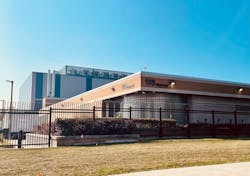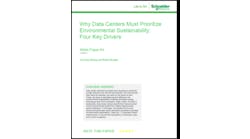Land and Expand is a regular feature at Data Center Frontier highlighting the latest data center development news, including new sites, land acquisitions and campus expansions. Here are some of the new and notable developments from hyperscale and colocation data center operators about which we’ve been reading lately.
Cologix, CIM Group complete joint-venture Toronto data center
Cologix and CIM Group in October announced the completion of their 15 MW Scalelogix TOR4 data center in Toronto. A joint venture, the partners contend the strategically located data center solidifies Toronto's position as a pivotal North American digital and connectivity hub.
Cologix provides carrier- and cloud-neutral hyperscale, colocation and edge data centers and services in 11 markets across North America, including Ashburn, Columbus, Dallas, Jacksonville, Lakeland, Minneapolis, Montréal, New Jersey, Silicon Valley, Toronto and Vancouver.
Founded in 1994, CIM Group is a real estate and infrastructure owner, operator, lender and developer headquartered in Los Angeles, with offices in Atlanta, Chicago, Dallas, London, New York, Orlando, Phoenix and Tokyo. The company is an active owner and investor in data centers across North America.
Encompassing 50,000 SF on a 3.4-acre campus, a significant portion of the three-story Scalelogix TOR4 data center has been pre-leased by a major global business anchor tenant. However, the partners report that additional space is available.
"Strong demand from major global cloud providers and prominent digital enterprises continues to drive us to actively enhance our Scalelogix portfolio throughout North America," said Cologix's Chief Revenue Officer, Chris Heinrich.
A $3 billion recapitalization of Cologix in December of 2021 set the stage for the Scalelogix platform, an initiative to deploy 200 megawatts of capacity in key hyperscale markets. The Scalelogix hyperscale design features innovations in how Cologix facilities are built and financed.
The Scalelogix strategy was enabled by the recapitalization, which brought in new investors and used an asset-backed securitization to reduce the company’s borrowing costs, as reported by DCF's Rich Miller at the time.
"Cologix provides an example of how investment and M&A can alter the trajectory of a data center provider’s journey," wrote Miller, while noting how, "Five years ago, Cologix was a regional colocation provider offering interconnection services from modest-sized data centers. It is now a player in the hyperscale data center market, building larger data centers to provide cloud on-ramps in major hyperscale hubs."
Supported by its 15 MW of power and associated cooling infrastructure, TOR4 is designed to meet the performance and security demands of mission-critical operations. The data center's cooling system is designed to maximize energy efficiency via its free-cooling capabilities and green roof capacity. The facility's two planned data halls feature exclusive cages and an approximate capacity of 1,000 cabinets.
The data center's power distribution is strategically redundant, enhancing stability while minimizing downtime, with multiple back-up generators and dedicated units supporting the cooling infrastructure.
TOR4 draws on Cologix’s interconnection "ecosystem" of more than 700 networks, 350 cloud providers, 30 public cloud onramps and six internet exchanges. The facility includes multiple physically separated, diverse Meet-Me-Rooms with various fiber entrance vaults to the campus. Metro area dark fiber access is also available.
The data center is fortified with dual, interlocked, pre-action fire suppression systems with cross-zoned VESDA [Very Early Smoke Detection Apparatus] technology for comprehensive fire detection, along with leak detection systems deployed around piping and drains. The facility includes anti-intrusion and CCTV systems, biometric scanners and badge access. Customized security is available.
Heinrich concluded, “TOR4 embodies our vision of providing cutting-edge hyperscale data center solutions that empower businesses to thrive with rapid connectivity, ultra-low latency, robust security and essential network access, which are vital to helping our customers grow their businesses at the digital edge.”
DataBank's Busy October
DataBank had a very busy October.
The colocation, connectivity and managed services specialist began the month by announcing the expansion of its flagship DFW3 data center in Dallas to meet growing demand from the southwest U.S. region’s technology stakeholders. The new development will add 22,000 SF of raised floor space and 3 MW of critical power, inclusive of a dedicated catcher reserve block, as standard for the company.
Located on a 16-acre campus at 8375 Dominion Parkway in Plano, Texas, DFW3 is powered by dual feeds from an off-site Oncor substation. The facility currently delivers 20 MW of power and provides metro connectivity via data center interconnect technology to DataBank’s other Dallas data centers, located some 20 to 30 minutes away.
DFW3 features an N+1 power design and an N+1 cooling scheme to assure uptime for customer compute resources. One of only three Uptime Institute Certified Tier III data centers in the state, DFW3 offers network availability to multiple dark fiber providers, and houses nodes for all DataBank cloud services, including the company's Enterprise Cloud, FedRAMP Cloud, SAN and Object Storage, Virtual Desktop Infrastructure, Storage as a Service, and Disaster Recovery as a Service offerings.
“The Plano campus design streamlines this expansion as we had already created scalable space and power options for customers requiring higher-density colocation services,” said DataBank Vice President of Construction, Tony Qorri. “The expansion of our very first data center also syncs with the growing importance of the Dallas area in the data center ecosystem that connects users across the U.S. and South America.”
Then in the middle of the month, DataBank announced the planned expansion of one of its six Utah data centers.
To continue supporting the western U.S. region’s growing technology footprint, DatBank expects to complete the expansion of its SL6 facility in Q1 of 2024. The expansion will add 25,000 SF of raised floor space and 6 MW of critical power capability.
Located on the “Silicon Slopes” of Utah at 14870 South Pony Express Road in Bluffdale, SL6 is part of the DataBank Granite Point Campus, which consists of four other data centers. The campus is located 25 minutes from another DataBank data center in downtown Salt Lake City.
The SL6 colocation data center currently provides nearly 90,000 SF of raised floor space for compute resources, along with 22 MW of critical power and an established presence of 13 carriers for connecting DataBank customers. SL6 opened in 2023 as the fifth and final DataBank data center on the Granite Point Campus.
The facility currently features N+1 power and cooling to assure uptime for customer compute resources and a 66 MW substation for additional power capacity. The data center also complies with SSAE 18, HIPAA, PCI-DSS, ISO 27001, and GDPR standards and regulations.
“The SL6 expansion is primed to support the Salt Lake City area, which is one of the fastest-growing technology hubs in the country,” noted DataBank Vice President of Construction, Tony Qorri. “Salt Lake City is a go-to data center destination, not only for innovators but also as an alternative to expensive data centers in California. Our infrastructure resources are particularly helpful for data science innovation and supporting the region’s many tech startups."
Finally, on the last day of October, DataBank announced its acquisition of 95 acres of land near Lithia Springs in the burgeoning Atlanta market, which as recently noted by this publication is currently in the midst of a hyperscale-driven data center building boom.
Also in October, Microsoft announced its planned investment more than $1 billion in Rome and Floyd County, Georgia, where it purchased nearly 350 acres of land to develop a data center campus.
Last month also saw Stack Infrastructure filing plans to build a data center campus in Douglas County’s Lithia Springs. As first reported by Data Center Dynamics, the $380.9 million project calls for construction of a pair of three-story data center buildings totaling 879,000 SF, and is set for completion in 2026.
DCD further noted that Digital Realty, CoreSite, Switch, Google, Microsoft, Flexential, H5, and QTS all have or are developing data centers in the Atlanta area, mainly in the vicinity of Lithia Springs and Douglasville.
DataBank expects its freshly acquired 95 acres in Lithia Springs to dramatically expand its capacity and ability to meet growing regional demand for colocation space and power over the next decade. The site is within a half-mile of an existing 18 acres DataBank already owns nearby, upon which it is constructing its ATL4 facility.
Located just 20 minutes outside of Atlanta, DataBank's new 95-acre land parcel can accommodate two multi-story data centers totaling up to 1 million gross square feet of space. The site will include a 180 MW onsite sub-station from Georgia Power capable of delivering up to 120 MW of critical IT power when fully deployed.
DataBank said the site will allow it to continue serving the fast-growing colocation needs of enterprises and hyperscale public cloud providers that have already established a strong presence in the area, as has the operator.
The new campus, and the facilities ultimately built upon it, will all leverage DataBank’s recently announced Universal Data Hall Design (UDHD), which the company said marshals "the highest possible power and cooling density" to ensure capacity can be quickly deployed to meet the wide-ranging sustainability and performance requirements of its customers amid emerging AI applications.
“Atlanta is one of the most sought-after markets for data center capacity across all segments of our customer base – enterprises, technology, and hyperscale public cloud providers,” said Raul K. Martynek, DataBank’s CEO. “And now with new AI applications coming online, we’re seeing an entirely new driver of demand that promises to make this an even more attractive market in the years ahead.”
Meta Goes In Once More For $800M Data Center In Temple, Texas
Kansas City, Missouri-based general contractor JE Dunn last month resumed construction on Meta's $800 million data center project in Temple, Texas.
As noted by ConstructionDive, the project was deferred in December 2022 when Meta announced it would change the design of the complex. Meta says its re-tooled data center design is now heavily optimized to support the next generation of AI systems. Per DCD reporting, Meta believes the new design will be 31% less expensive and take half the time to build over previous approaches.
Along with JE Dunn, other construction companies working on the Temple, Texas data center project include Rosendin, Brandt Companies, Peabody General Contractors, Alamo Structural Steel, Perry and Perry Builders, CentiMark Corporation, and BakerTriangle.
At the project's peak, Meta anticipates over 1,200 construction workers to be on site.
In the following recent video from Central Texas NBC TV affiliate KCEN News, municipal leaders in Temple discuss the new Meta data center's impact on their town.

Matt Vincent
A B2B technology journalist and editor with more than two decades of experience, Matt Vincent is Editor in Chief of Data Center Frontier.







